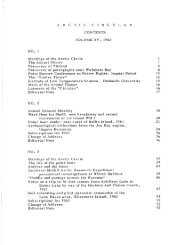Volume 4, 1951 - The Arctic Circle - Home
Volume 4, 1951 - The Arctic Circle - Home
Volume 4, 1951 - The Arctic Circle - Home
You also want an ePaper? Increase the reach of your titles
YUMPU automatically turns print PDFs into web optimized ePapers that Google loves.
One long-range wireless set was carried by the control<br />
wannegan for contact with base; the other trains were equipped<br />
with shorter range sets for communication vvith the control<br />
wannegan.<br />
<strong>The</strong> original date for the start of the operation was<br />
January 9, but the freeze-up was late and ice conditions on<br />
the Churchill River were not considered satisfactory for<br />
heavy equipment. After four days, ice conditions had improved<br />
very little. However, further delay was undesirable,<br />
so the light trail breaker party, consisting of one D6<br />
tractor, one 10-ton cargo s1eigh, and a wannegan, was sent<br />
up the Churchill River to find a crossing and if possible<br />
to break the trail to Seal River since a check of ice conditions<br />
and a general report on the Seal River (which had<br />
been reported by the air observer as being still open) were<br />
urgently required. <strong>The</strong> trail breaker party was able to<br />
cross the Churchill River approximately 10 miles upstream<br />
and made the trip to Seal River, returning to Churchill on<br />
~anuary 19 with the report that once across the Churchill<br />
the going was good to the Seal but there again it would be<br />
ne~essary to travel up the river in order to locate a<br />
satisfactory crossing. <strong>The</strong> operation was carried out by<br />
making two round trips to Ennadai Lake. <strong>The</strong> first swing<br />
of heavily laden tractors departed fram Fort Churchill on<br />
25 Januar-y 1949 for Ennadai Lake and returned on March Il,<br />
a total of 46 days for the round trip of approximately 940<br />
miles. <strong>The</strong> second swing departed Fort. Churchill on March 20<br />
for Ennadai Lake and returned on April 17 (29 days). This<br />
trip causedmuch concern as civilian tractor operators considered<br />
it would not be possible to complete the round trip<br />
before the spring break-up, but the risk had to be accepted<br />
if the Ennadai Station was to be campleted during the summer<br />
of 1949. It is worth noting here that once the tractor<br />
trail was established, the efficiency and the speed of the<br />
tractor train were increased and the turn around time was<br />
cut to almost one-half that of the original trip.<br />
More than average mechanical difficulties were<br />
encountered with the tractors as none of them were new.<br />
<strong>The</strong> majority had been used on Engineer projects for a<br />
number of years, some had been used on airports and the<br />
grousers had been welded onto the track plates. This had<br />
removed the temper from the track plates and caused a very<br />
high rate of replacement. Here the air supply unit was<br />
called upon and 900 Ibs. of spare parts were free-dropped<br />
from a Lancaster aircraft. 81eigh breakages were reasonably<br />
low but at one point a cargo sleigh loaded with 10 tons of












